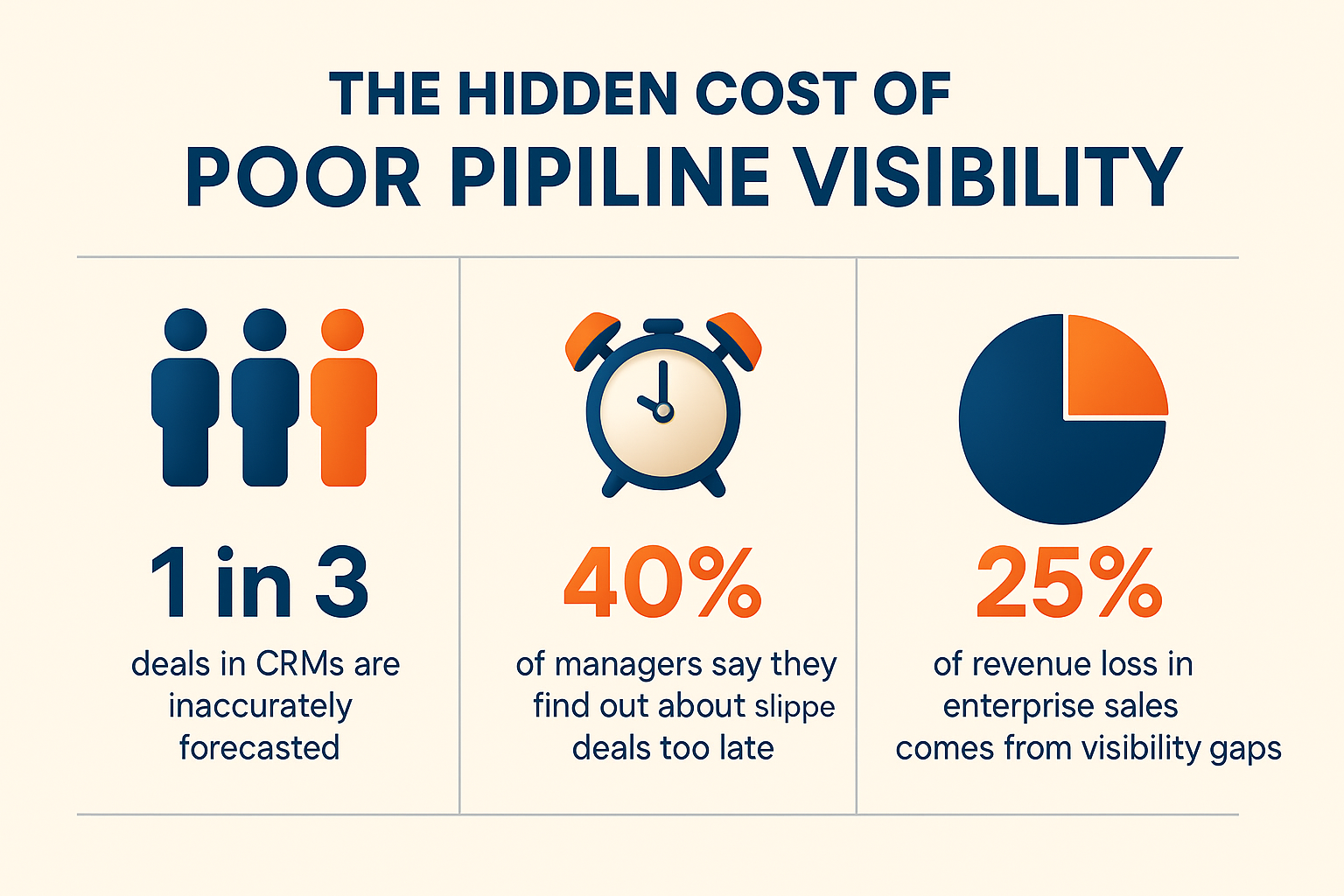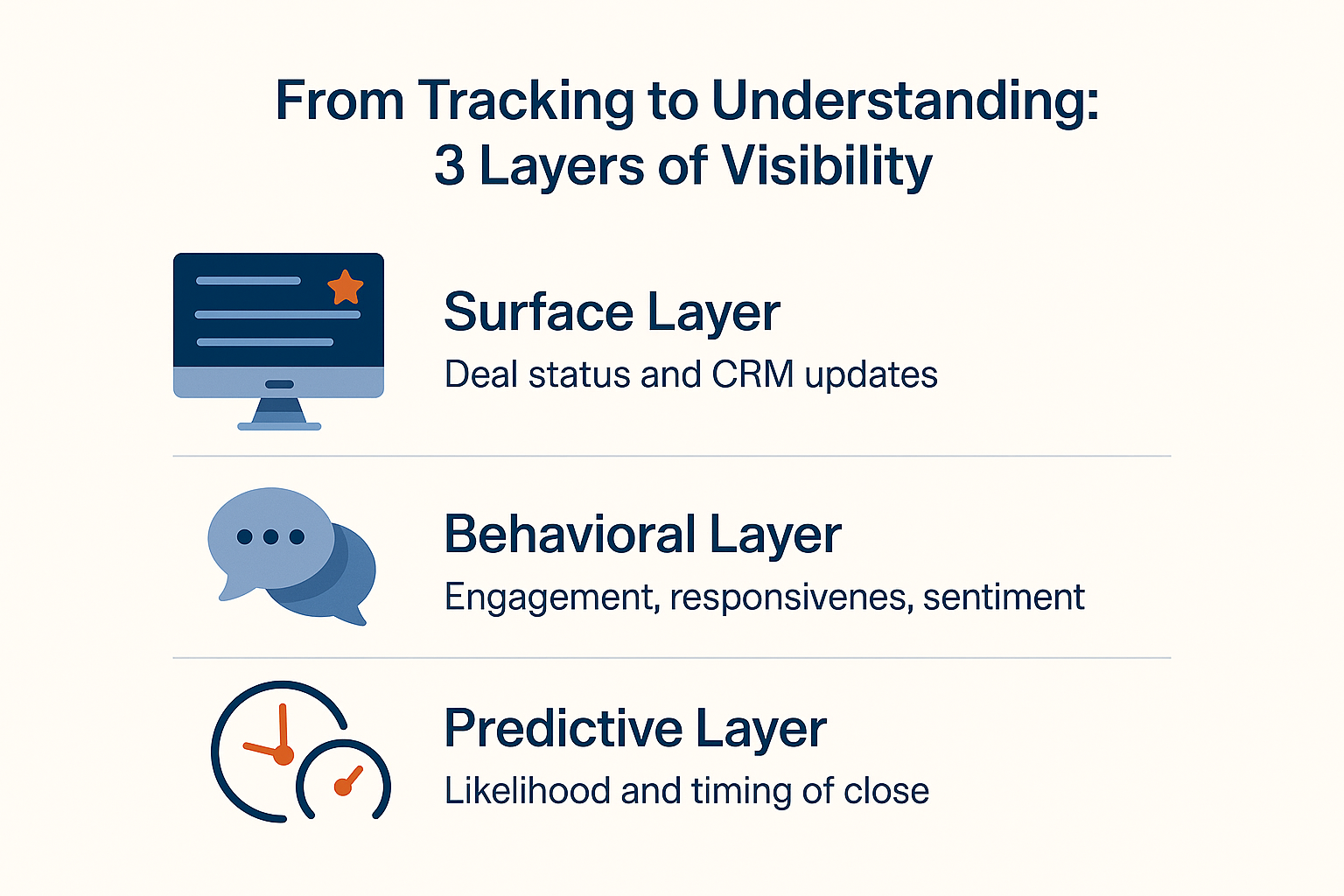
Sales leaders talk a lot about growth. But growth doesn’t happen because of bigger targets. It happens when your team truly understands what’s happening in your pipeline right now, not at the end of the quarter.
Unfortunately, most companies think they have pipeline visibility. In reality, they only see fragments. Deals that look healthy disappear without warning. Forecasts miss the mark. Reps chase the wrong opportunities. The problem is not effort. It’s the lack of clear, connected visibility into the sales pipeline.
Table of Contents:
- The Cost of Hidden Blind Spots in Your Revenue Pipeline
- Where Traditional Pipeline Management Falls Short
- The Illusion of Control
- Understanding the Real Nature of Pipeline Visibility
- Why Traditional Sales Forecasts Keep Failing
- The Human Side of Pipeline Visibility
- Pipeline Management in the Age of AI
- From Numbers to Narrative
- The Future of Sales Leadership is Transparency
The Cost of Hidden Blind Spots in Your Revenue Pipeline
When you can’t see your pipeline clearly, you can’t control it. It’s not just about missed numbers; it’s about the decisions that never get made.
Deals stagnate for weeks because no one knows where they stand. Reps spend time on low-probability opportunities because “it feels promising” Managers chase spreadsheets instead of coaching teams.
A huge SaaS client recently told us that 18% of their forecasted deals last quarter never closed. Not because the product failed, but because the pipeline visibility wasn’t aligned across teams. Marketing thought leads were qualified, sales thought they were ready to buy, and the truth was somewhere in between.
That 18% represented almost $3 million in potential revenue, lost not to competitors, but to the fog inside the pipeline.

Where Traditional Pipeline Management Falls Short
Most CRMs are designed to record data and not interpret it. They tell you what happened, not what’s happening or what is about to happen.
This is where traditional pipeline management starts cracking. Spreadsheets, manual updates, and static reports can’t keep pace with how modern sales cycles work. Every conversation, email, and interaction adds nuance. But if your system doesn’t capture and interpret it, the context is lost.
For example, a rep marks a deal at 80% confidence, but engagement data shows the buyer hasn’t opened a proposal in 10 days.
A stuck deal may have strong signals of intent buried in email threads or meeting notes that no one reviews. Without real-time visibility, these insights are hard to notice. That’s why sales pipeline management powered by AI is becoming less of a privilege and more of a standard.
The Illusion of Control
Traditional pipeline management practices often create a sense of control that doesn’t really exist. Managers review numbers every Monday. They track weighted pipelines. They discuss top deals during reviews. On the surface, it feels rigorous.
But those numbers represent snapshots, not movement. The pace of engagement, buyer sentiment, or internal decision shifts are rarely reflected.
A VP of Sales once described it this way:
“Our CRM looked perfect, but it was lying to us. We were managing reports, not reality.”
The tools weren’t broken. The model was. Pipeline management, as it has existed for decades, assumes that visibility is about tracking. But true visibility is about understanding.
Understanding the Real Nature of Pipeline Visibility
Pipeline visibility is not just about seeing deals. It’s knowing which deals are alive, which are drifting, and which never had a chance to begin with. It’s connecting human behavior, buyer responses, engagement signals, and intent patterns to numerical probability.
Imagine two deals in the same stage, both marked at 70% confidence. One has consistent buyer engagement, fast replies, and multiple stakeholders participating. The other has gone quiet for two weeks.
They’re not the same deal, yet in most CRMs, they look identical. That’s the visibility gap.
Pipeline visibility should answer three questions for every deal:
- Where are we actually? (current behavior, not last update)
- What’s likely to happen next? (based on historical and behavioral data)
- What’s missing or at risk? (deal health indicators)
The difference between teams that hit targets and those that miss them often comes down to how early they can answer these questions.

Why Traditional Sales Forecasts Keep Failing
Leaders often trust forecasts because they appear data-driven. There are formulas, probabilities, and historical patterns. But those forecasts are only as good as the visibility beneath them.
When reps mark deal stages manually, they embed human bias. Optimism inflates probabilities. Pressure at the end of the quarter skews reporting. A deal that “might close next week” becomes “90% likely.”
AI has started to correct this, but even AI forecasts can fail when the data feeding them is incomplete or disconnected. The key is not replacing human judgment, but enhancing it with live visibility.
True AI sales forecast models don’t just analyze close rates. They track deal engagement, response frequency, sentiment in communications, and the alignment between buyer and seller activity.
When these layers combine, the forecast shifts from being a number to being a narrative, a living reflection of reality.
Gain Visibility into Your Pipeline
The Human Side of Pipeline Visibility
Visibility is not just a technology challenge. It’s a behavioral one. Reps update deals based on what they feel, not what the buyer signals. Managers trust updates that match their expectations. Leadership pressures accuracy but often rewards optimism.
This creates a feedback loop that hides truth under confidence. To change that, visibility must become cultural. It starts with questions like:
- Are we rewarding accurate forecasting or just big pipelines?
- Do we treat lost deals as insights or as failures?
- Are we capturing conversations or just conversions?
In a renowned tech company, leadership began reviewing deal narratives instead of deal numbers. They encouraged reps to explain what buyers were saying and how engagement was trending. Within two quarters, their win rate rose by 11%. They didn’t buy a new tool. They built a new lens.
Pipeline Management in the Age of AI
Sales today move faster, with more stakeholders, more noise, and more channels. The static CRM model cannot keep up. Visibility must evolve from data review to dynamic intelligence.
That means orchestrating multiple systems, CRM, marketing automation, and communication platforms into a single, live view of the pipeline. It’s not about adding more dashboards. It’s about seeing movement in real time.
Modern AI-driven revops platform integrates signals from every stage:
- Prospect engagement in campaigns
- Email and meeting frequency
- Stakeholder alignment across the buying group
- Deal velocity relative to the benchmark
When visibility is complete, managers coach differently. Instead of asking, “What’s the status of this deal?” they ask, “What’s the story behind this deal?” That question alone changes how teams think and act.
From Numbers to Narrative
Every lost deal tells a story. The challenge is whether your current system can tell it before it’s too late. Visibility gives teams the ability to act before damage occurs to redirect effort, re-engage buyers, and reallocate time intelligently.
When leaders finally see the truth of their pipeline, something subtle but powerful happens: pressure turns into precision. Teams start spending their time where it matters most. Forecasts stop being hopeful guesses and start being operational tools.
Pipeline visibility is not just a platform upgrade. It’s a strategic shift. It changes how organizations measure trust, alignment, and progress. If you want more accurate forecasts, you don’t start with numbers. You start with visibility.
The Future of Sales Leadership is Transparency
The best teams will not be those that sell the most, but those that see the clearest. When visibility becomes the foundation, every forecast improves. Every meeting becomes shorter. Every quarter becomes more predictable.
Pipeline visibility is not about control; it’s about understanding. And in the next decade of competitive selling, understanding will be the only real advantage that lasts.
